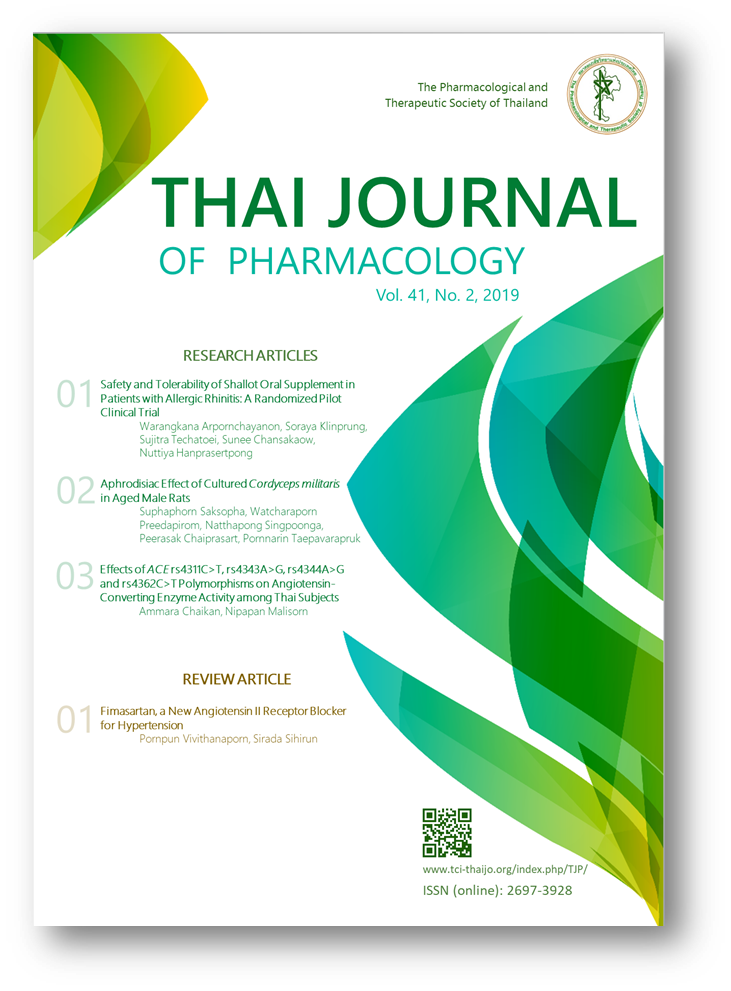Safety and Tolerability of Shallot Oral Supplement in Patients with Allergic Rhinitis: A Randomized Pilot Clinical Trial
Main Article Content
Abstract
Shallot has long been suggested in Thai folk medicine to prevent allergic rhinitis (AR), but no scientific evidence on safety and tolerability is available to support the continuous use. The purpose of this study was to evaluate the adverse effects of the continuous use of oral shallot supplement in AR patients and determine the safety and tolerability by comparing the results with placebo. A prospective, randomized, double-blind, placebo-controlled, pilot study was performed in 50 AR patients. All patients received cetirizine 10 mg per day as standard treatment. An additional 3 g per day of either shallot capsules (equivalent to 1½ bulbs of fresh shallot) or placebo capsules were randomly prescribed for 4 weeks. Complete blood counts (CBC), blood urea nitrogen (BUN), serum creatinine (Cr), aspartate aminotransferase (AST), and alanine aminotransferase (ALT) levels were evaluated before and after treatment. Vital signs and physical examination were performed before starting the study and repeated every 2 weeks thereafter. Assessment of adverse events and patient’s compliance were performed every 2 weeks. Patients’ satisfaction was assessed via visual analog scales in an exit interview. Twenty-five patients in the shallot group and 22 patients in the placebo group completed the study. No significant differences between groups were found in terms of body weight, blood pressure, heart rate, incidence of adverse events, compliance, serum levels of CBC, BUN, Cr, AST, and ALT, and patients’ satisfaction. In conclusion, the combination use of oral shallot supplement with cetirizine for 4 weeks is safe and well tolerated in AR patients.
Article Details
Upon acceptance of an article, the Pharmacological and Therapeutic Society of Thailand will have exclusive right to publish and distribute the article in all forms and media and grant rights to others. Authors have rights to use and share their own published articles.
References
2. Fattorusso E, Iorizzi M, Lanzotti V, Taglialatela-Scafati O. Chemical composition of shallot (Allium ascalonicum Hort.). J Agric Food Chem. 2002 Sep 25;50(20): 5686-90.
3. Charoenchai L, Settharaksa S, Sueree L, Wunnakup T, Phetmanee T, Lukkuna- prasit T, et al. Antioxidant, antimicrobial, tyrosinase enzyme inhibition and chemical compositions of shallot extracts. BHST. 2017;15(1):17-27.
4. Mikaili P, Maadirad S, Moloudizargari M, Aghajanshakeri S, Sarahroodi S. Therapeutic uses and pharmacological properties of garlic, shallot, and their biologically active compounds. Iran J Basic Med Sci. 2013 Oct;16(10):1031-48.
5. Wongmekiat O, Leelarugrayub N, Thamprasert K. Beneficial effect of shallot (Allium ascalonicum L.) extract on cyclosporine nephrotoxicity in rats. Food Chem Toxicol. 2008 May;46(5):1844-50.
6. Ismail A, Marjan ZM, Foong CW. Total antioxidant activity and phenolic content in selected vegetables. Food Chem. 2004 Oct;87(4):581-6.
7. Werawattanachai N, Kaewamatawong R, Junlatat J, Sripanidkulchai B. Anti-inflammatory potential of ethanolic bulb extract of Allium ascalonicum. J Sci Technol UBU. 2015 May-Aug;(17)2:63-8.
8. Arpornchayanon W, Klinprung S, Chansakaow S, Hanprasertpong N, Chaiyasate S, Tokuda M, et al. Antiallergic activities of shallot (Allium ascalonicum L.) and its therapeutic effects in allergic rhinitis. Asian Pac J Allergy Immunol. 2019 Aug 18. doi: 10.12932/AP-300319-0529. [Epub ahead of print]
9. Dhulappa M. Allium ascalonicum Linn.-an ayuravedic perspective. IAMJ. 2014 Jul-Aug;2(4):478-82.
10. Mohammadi-Motlagh HR, Mostafaie A, Mansouri K. Anticancer and anti-inflammatory activities of shallot (Allium ascalonicum) extract. Arch Med Sci. 2011 Feb;7(1):38-44.
11. Pitiporn S. Herbs for living without diseases “Thai way of heathy life with Aphaibhubet” for self-reliance. 16th ed. Bangkok: Poramudh publication; 2012. (Thai)
12. Pawankar R, Bunnag C, Khaltaev N, Bousquet J. Allergic rhinitis and its impact on asthma in Asia Pacific and the ARIA Update 2008. World Allergy Organ J. 2012 Apr;5(Suppl 3):S212-7.
13. Greiner AN, Hellings PW, Rotiroti G, Scadding GK. Allergic rhinitis. Lancet. 2011 Dec 17;378(9809):2112-22.
14. Guo R, Pittler MH, Ernst E. Herbal medicines for the treatment of allergic rhinitis: a systematic review. Ann Allergy Asthma Immunol. 2007 Dec;99(6): 483-95.
15. Finn DF, Walsh JJ. Twenty-first century mast cell stabilizers. Br J Pharmacol. 2013 Sep;170(1):23-37.
16. Hon KL, Fung CK, Leung AK, Lam HS, Lee SL. Recent patents of complement- ary and alternative medicine for allergic rhinitis. Recent Pat Inflamm Allergy Drug Discov. 2015;9(2):107-19.
17. Mlcek J, Jurikova T, Skrovankova S, Sochor J. Quercetin and its anti-allergic immune response. Molecules. 2016 May;21(5):623.
18. Tashiro M, Kato M, Miyake M, Watanuki S, Funaki Y, Ishikawa Y, et al. Dose dependency of brain histamine H1 receptor occupancy following oral administration of cetirizine hydrochloride measured using PET with [11C]doxepin. Hum Psychopharmacol. 2009 Oct;24(7):540-8.
19. Sobenin IA, Andrianova IV, Fomchenkov IV, Gorchakova TV, Orekhov AN. Time-released garlic powder tablets lower systolic and diastolic blood pressure in men with mild and moderate arterial hypertension. Hypertens Res. 2009 Jun; 32(6):433-7.


